The best prevention is to be sure your trees are healthy and happy

Woodpeckers are part of the Picidae family that also includes piculets, wrynecks, flickers, and sapsuckers. They are found in most of the world except for Australia, New Zealand, Madagascar, and extreme polar regions. We have 17 species here in California.
They can range in length from just under 3 inches to nearly 20 inches and can be fairly drab in color (olive and brown) to vividly bold (bright red, black, white and gold). They have short, strong legs, and most species have four toes, two of which face backward, making it exceedingly easy to climb and grasp onto tree trunks and limbs.
Although it may seem that a persistent woodpecker is killing your tree, the opposite is generally true. Woodpeckers actually feed on insects that have invaded the bark of an already distressed tree.
Woodpeckers are attracted to wood-boring beetles, termites, carpenter ants, caterpillars, and spiders. However, they will also eat nuts, fruit, bird eggs, lizards and small rodents.
They prefer wood that is already dead for their foraging and nest building. Since most trees have some amount of dead wood, these birds are usually not considered harmful. When they detect insects within decaying wood, they use their strong beaks to make small holes and then extract the prey using their extremely long, barbed tongues.
Sapsuckers, as the name implies, prefer to feast on tree sap and the insects that are attracted to tree sap. These birds are known to voraciously attack trees, causing serious damage and sometimes death to the tree. They are migratory birds and can wreak havoc on entire groves of trees throughout the United States. According to the U.S. Forest Service, sapsuckers cause mortality rates in 67 percent of gray birch, 51 percent of paper birch, 40 percent of red maples, 3 percent of red spruce, and 1 percent of the hemlock that they attack.
They frequently return to the same trees year after year. They increase the size of their holes, looking for more sap and inflicting more and more damage. As the tree declines, bacteria and fungus can take hold, amplifying the damage and increasing the likelihood of tree mortality.
Sapsuckers usually make tiny holes in a horizontal pattern around the tree, while woodpeckers mostly make large, random holes. Most damage is caused during their breeding season that runs from February to June.
All woodpeckers are protected under the Migratory Bird Treaty Act of 1918, and some are listed as endangered species.
So what can you do to protect your trees?
Wrap burlap or hardware cloth around the areas of the tree that have been attacked. There are also repellents such as Tanglefoot Bird Repellent that will help fend off the noisemakers. However, when deterred, they will usually seek out another tree. If they are attacking an already sick tree, one you are not particularly fond of or one that is not in the best location, it may be best to just let them peck in peace!
The best preventative measure is to regularly inspect your trees for signs of infestation. Termites and carpenter ants love to feast on wood, and trees are a good source. So, if you see an invading pest, deal with it right away.
First and foremost, determine what type of pest you have and then use an eco-friendly, organic method of control. When using any pesticide, (organic or conventional) it is important to determine exactly which type of pest you are trying to kill and use only the recommended dose. More is definitely NOT more, and if you aren't careful, you can wipe out an entire ecosystem of beneficial insects and species.
by UC Master Gardener Rebecca Jepsen
This article first appeared in the February 17, 2019 print issue of the San Jose Mercury News.

